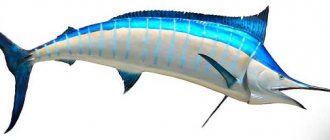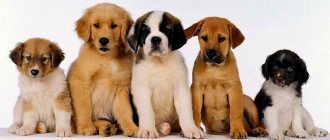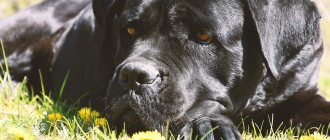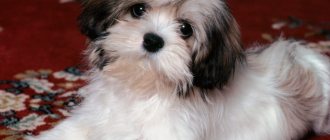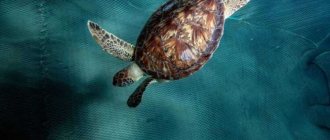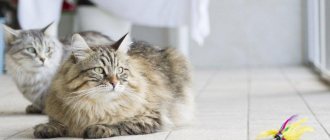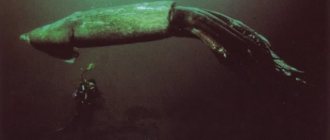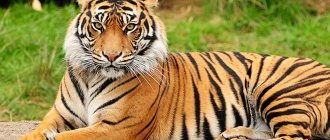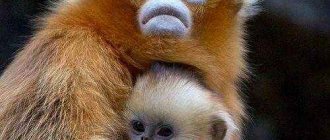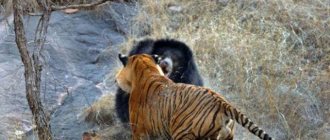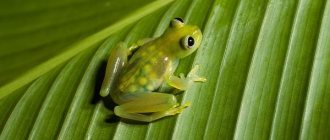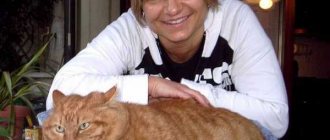Each person in his own way represents the most beautiful and unusual breed of cats. Some people cannot imagine a pet without a soft and fluffy fur coat, while others will choose a hairless friend. Some felines naturally have original features: curly hair, lack of a tail, long torso or large size. What cat can be called the most unusual in the world?
Lykoy cat werewolf
Likoi - scary on the outside, kind on the inside
The appearance of a Lykoi cat often raises concerns about its health and adequacy. The roan, half-bald creature only vaguely resembles a domestic purr. Hence the name. Translated from ancient Greek, λύκοι means wolf, and werewolves were called lycontropes in Europe.
Lykoi appeared as a result of a natural mutation in the hair of the domestic shorthaired cat, which was subsequently fixed through competent selection.
Lykoi's fur feels like human hair. It is rare and completely devoid of undercoat. The color is atypical for cats - roan (the ideal ratio of black and white hair is 50/50). At the same time, the werewolf cat is partially naked, which adds to her resemblance to a mystical creature. No pathologies or genetic abnormalities were identified in the breed.
It is interesting that there are long queues for kittens from the best nurseries. They cost an average of $1,500.
Naked mole rat
The naked mole rat (Heterocephalus glaber) is an extremely interesting rodent native to Africa.
The naked mole rat (also called the desert rat) lives in underground tunnels and rarely comes to the surface. The sausage-like creature is notable not only for its specific appearance, although the naked, sparsely haired, wrinkled pale skin, and especially the protruding teeth, you will agree, make an indelible impression. They say that with its sharp and hard, diamond-like teeth, the beast is able to gnaw through even concrete!
These animals are also unusual in that they have an exceptionally high life expectancy for rodents (up to 30 years). Naked mole rats do not have strokes, heart attacks, cardiovascular diseases, diabetes, fatal liver or kidney diseases, and their organs and tissues do not wither at all over time. This is the only creature that practically does not feel pain. Another unique feature of the animal is that it can do without oxygen for up to 20 minutes! This ability makes naked mole rats similar to plants!
The naked mole rat has recently come under close attention from scientists. Perhaps someday, thanks to this very creature, gerontologists will be able to answer the question: How to slow down aging?
Toyger
Domestic mini tiger
A young American breed of domestic cats with an original striped color. The breed was developed in the USA in the late 80s by crossing Bengal cats and domestic shorthairs of an atypical merle color.
The new breed was born thanks to the efforts of Judy Sugden, the daughter of the world-famous felinologist Jean Mill (Sugden), who bred the Bengal cat. The name of the breed is formed by merging the English words toy - toy and tiger - tiger.
Judy was working on improving the color of her marbled Bengals when she noticed that one of her pets had spots on her temples that looked like arrows. It took a long time to choose a groom for this cat. As a result, he became a street cat brought from Kashmir, India. He had unusual stripes on his ears. Two such insignificant, at first glance, details made it possible to obtain a circular striped tabby color. It is not found in any other domestic cat.
Toygers are affectionate and friendly, very energetic and playful until old age. Their habits are no different from ordinary cats, but their color is admirable. The breed is considered rare and expensive throughout the world. A kitten from a nursery costs an average of $1,800.
No wool
Sphynxes are amazing: some representatives of this breed do not have a hair on them. But still, this feature does not occur very often; many subspecies of sphinxes still have a certain amount of thin and sparse hair.
Prominent representatives of sphinxes:
- Canadian. A little fluff on their body is acceptable, but it is practically invisible.
- Donskie. There is no hair on their body at all. Such cats are often chosen by people with allergies.
- Ukrainian Levkoy. They are distinguished not only by the absence of a fur coat, but also by their drooping ears. The breed is young. In 2007, she was officially registered by breeders from St. Petersburg.
- Peterbalds. Originally from St. Petersburg. Gradually, the breed became one of the most popular among lovers of hairless cats.
- Elves. A completely new look. They got their name from the original shape of their ears.
In contrast to hairless cats are furry felines. Some of the most interesting are exotics.
Munchkin
Munchkin - the “dachshund” in the cat world
The breed in question is one of the most discussed in the cat kingdom, and its main distinguishing feature is its very short legs. Munchkins like to sit on their hind legs, like gophers, and often grasp objects with their front legs. They are jokingly called dachshund cats or simply shorties. They conquered the world so quickly that the term “munchkinomania” even appeared on the Russian-speaking Internet.
It is known that short-legged cats were bred in the 30s in England. Then 4 generations of shorties were born. But the Second World War made its own adjustments and the breed could not be preserved. The modern history of munchkins began in the early 80s, when American Sandra Hochenedel from Louisiana picked up a black and white pregnant cat with short legs on the street and named her Blackberry. Of several kittens, one inherited its mother's feature. They named him Tuluus. Blackberry and her own son became the bosses of all modern munchkins.
The breed owes its name to the short magical people described in the book “The Wizard of Oz.” Munchkins have given rise to several new experimental breeds.
The Munchkin's body is slightly elongated, its legs are 2-3 times shorter than those of an ordinary cat. They are playful, cheerful and loving creatures by nature, who are not upset if they cannot jump on a high table, but find other exciting fun on the floor. Prices fluctuate within a very wide range.
Manx
The main feature of these cats is the absence of a tail.
The breed was formed mainly in the wild, on the Isles of Man (Great Britain). According to legend, the ancestors of Manx cats were former sailor cats who survived shipwrecks. The tailless gene, which appeared due to a random mutation, soon became dominant in this peculiar community, and gradually the trait began to be passed on to all kittens.
After some time, animals began to be imported to Europe. The first breed standard was published already in 1903. Now Manxes are recognized by all major felinological organizations.
Manx cat formed in the wild
Appearance
The head is round, wide, with prominent cheekbones. The eyes are large and slanted. The ears are large, with rounded tips. The neck is strong and short.
The body is square, the croup is round. The hind limbs are longer. Paws are rounded. Weight ranges from 3.5 to 5.5 kg.
Tail Types:
- Dimple rumpy or rumpy - the caudal vertebrae are missing, in their place you can feel a fossa;
- Riser or rumpy riser - vertebrae hidden under fur;
- Stumpy - 1–3 visible vertebrae;
- Tailed or longy is a regular tail.
The wool is plush to the touch.
One of the characteristic features of this breed is the roundness of all shapes.
Character
Manxes are cats of one owner, and they choose him at their own discretion. The attitude towards the rest of the household is friendly, but rather restrained.
According to reviews, many Manx cats define their “rank” in the family as second after the main owner.
They are active and playful and jump very high. They often bring abandoned toys on their own initiative. They love to look at the water and play with the streams from the tap, but not to swim.
They get along well with dogs and other cats, but if necessary they can defend their interests quite harshly.
You should not allow access to small animals - Manx are excellent hunters.
My relatives got Manx. They first became acquainted with his agility when the kitten jumped without a run onto the lid of a rather high-standing aquarium. The glass underneath him slid sideways, and he himself ended up in the water, so there was quite a commotion. Since then, the aquarium has been covered with a special plastic lid, and all fragile items have been removed from the shelves. Not in vain - with age, this cat learned to take a height almost as tall as a man.
Care
Manx cats are brushed once a week, and during the molting period - every 1-2 days.
The breed is susceptible to tartar formation, so teeth should be brushed at least once a week, if possible more often.
Photo gallery: Menk cats
Animals with a complete absence of tails are rated highest at shows.
Manx cats benefit from walks in the fresh air.
Manx cats have a well-developed hunting instinct.
Manx are strong and resilient animals.
Although the average weight of Manx is relatively small, they look very massive
American Curl
The American Curl's ears can be curled back to varying degrees, the more, the more valuable he is.
A breed of semi-longhaired cats with unique curled back ears. The first American Curls appeared in 1981 from an ordinary black cat named Shulamith, living in California.
Kittens are born with straight ears, which begin to curl within 48 hours and take up to 3-4 months to develop. In adult cats, they should be firm and stiff to the touch at the base, but with flexible tips.
The American Curl gave rise to several new breeds. The average cost in nurseries is $750.
Rare and expensive
List of the most expensive (cost in dollars):
- Laperm - three hundred to two thousand;
- Serengeti - six hundred to two thousand;
- Elf - six hundred to two thousand;
- Kao-Mani - seven to ten thousand;
- Savannah - from twenty-two to one hundred thousand.
Also read the article about the most expensive cat breeds.
The cost of a rare pet depends on its class, gender, and nursery. A PET-class kitten (without documents) will cost several times less than an individual from titled parents. The cost of females is usually higher than that of males. In foreign nurseries, animals are more expensive.
Read the article about the most beautiful cat breeds.
Skiff-toy-bob
The Scythian-toy-bob is one of the smallest cat breeds, but that’s not the only thing that makes it unique
Miniature Scythians with expressive blue eyes and Siamese coloring are usually born with short tails, which makes them look even smaller.
The author and creator of the breed is Elena Krasnichenko from Rostov-on-Don, Russia. By chance, her family received a small Siamese cat with several kinks on its tail and a pregnant “Siamese” cat with a short tail, which gave birth to several tailless small kittens. This was followed by painstaking work to consolidate the desired qualities, and already in 1993 the Skif-toy-bob was officially registered as an experimental breed, and in 2022 on a final basis.
By nature, Scythian beans are calm, affectionate and flexible. Some kittens are trained to work with children and participate in the feline therapy program in. Kitties who work with special needs children are not afraid of loud sounds, bursting balloons and sudden movements. The price of a kitten with documents is from 70,000 rubles.
Breeds with Unique Body Shapes
One of the criteria for the unusualness of a cat breed is the shape of the animal’s body.
There are cats that have non-standard body proportions, which attracts the attention of breeders
In the early 90s, a very unusual breed was created - the munchkin, which is also known as the dachshund cat. The reason for its appearance was a rather rare genetic mutation. Since then, short-legged cats with an elongated body have touched owners with their appearance. The limbs of such pets are two times smaller than those of other cats, and the only difficulty for them is overcoming heights.
A funny way to see something in the distance is to stand on their hind legs. At the same time, they rely on their tail and lower their forelimbs. Representatives of this breed get along quite well with people, since in general they are very flexible. It is worth noting that such cats are also friends with other pets, although in case of danger they are always ready to stand up for themselves.
Top articles: Laws of thermodynamics in biological systems
A derivative of the Munchkin breed is another miniature breed - the Napoleon. Such cats are famous for their neat shape and beauty, for the purpose of which they were bred in 1995 by Joe Smith. The result was obtained by crossing a Machkin with a Persian, due to which the Napoleon breed can be seen with a charming, slightly flat muzzle and long hair with a bushy tail. Currently, it is very difficult to breed such kittens, because most of their offspring do not meet the ideal requirements of the breed.
Another short-legged breed is the Minskin. These cats were the result of crossing Sphynxes with Machkins. The muzzles of these animals have mainly the features of a sphinx, while they inherited short legs and the shape of the body from the machkin. These cats have fur. By nature, they are quite active and sociable, but from time to time they need privacy in a secluded corner.
Non-standard nuances of the structure of the skeleton can also include the absence of a tail in a cat or the presence of a very short tail. The first case includes such a breed as Manx cats. According to legend, such an unusual cat sailed on a ship and after the crash ended up on the Isle of Man, where over time the same tailless kittens began to appear until a whole breed was formed. The vertebrae in the caudal region of these animals, as a result of a natural anomaly, are either completely absent or preserved in very minimal quantities.
Isle of Man cats are characterized by very thick hair, a rounded rear part of the body, a wide chest and a round head shape. All these features make the pet’s appearance very voluminous; such cats seem incredibly soft.
The character of bobtails is flexible. This trait, combined with natural intellectual potential, allows you to raise an intelligent pet with good manners. These cats love communication and movement.
The number of caudal vertebrae in bobtails reaches 7, but sometimes it is less. However, the average cat has approximately 23 vertebrae in this area. Another peculiarity of the body of representatives of this breed is the ability to produce, in addition to the two main sounds - purring and meowing, also a bizarre chirp, as well as a sound reminiscent of barking.
A unique breed is the Pixie Bob. Its exceptional feature is polydactylism, which is manifested by the presence of more than 5 fingers on the animal’s limbs. This sign does not bother the pet at all, but it does not occur in all cats of this breed. Such animals have a short tail, and there are small tufts at the ends of their ears.
It is noteworthy that the character of the representatives of the breed is calm, unobtrusive and tactful. But at the same time, such a pet is never against active pastime. Many owners of such cats note that the animals are very unpretentious in their maintenance. They show extraordinary devotion to their owner, while remaining rather cold with strangers.
Highland Links (Highlander)
The Highlander is a unique hybrid of the Desert Lynx and the American Curl.
The American experimental cat breed is a hybrid of the Desert Lynx and Curl. Its main distinguishing features are a short tail, folded back ears and a beautiful marbled color.
From the steppe lynx, the highleder inherited large size, independence and high intelligence. From the domestic Curl he inherited an unusual ear shape, peace-loving nature and calm character. Highland Lynx cats are not talkative cats. He prefers to hide from annoying attention and is not able to clearly express his emotions. He is not at all phlegmatic, but he is unlikely to swing the chandelier and tear the curtains.
The breed is rare, but promising. The cost of kittens can reach $3,000.
Cymric
According to legend, Cymric cats lost their tails when they jumped into Noah's Ark at the last minute. The absence of a tail, partial or complete, is the main distinguishing feature of the breed. But this is not the only reason why the Cymrik made it into our TOP “The most terrible cat breeds”. The animals have a strong, stocky body, powerful hind legs that are longer than the front legs.
Kymriks are hunter cats. They are very inquisitive, agile and can climb to the highest places in the house. This causes discomfort to cat owners; they complain that cats take things from the highest shelves.
What is the price
There are no nurseries of this breed in Russia and Ukraine. In the USA, such kittens are sold at prices ranging from $350 to $1,500.
Author's comment
If your dream is a stocky, powerful cat that looks like a sumo wrestler constantly, the Cymrik will be the perfect choice!
Bambino
The Bambino cat is much more agile than it seems
Another hero of the list is the bambino. A hairless breed of cat with short legs. As you might guess, she appeared as a result of crossing a munchkin and a sphinx.
The history of the bambino began in 2000, when a short little munchkin was brought to the Sphynx nursery of the Osborne couple from Arkansas. Breeders immediately became interested in what would happen if two unusual breeds were crossed. The result can be seen in the photo: a small naked miracle with a large head on short legs. Bambino is translated from Spanish as “child”.
It is interesting that, in parallel with American breeders, a similar breed was bred in Russia, in the nursery of the Chernov sisters, Baby Moon Cattery. In 2005, when their cats were officially registered, there were already 4 generations.
Bambinos are not known for their grace and sophistication, but they are funny and funny. Surprisingly agile and jumping. Absolutely devoid of aggression and hunting instincts. The average price of a bambino in nurseries is $800.
Rex
The main distinguishing feature of Rex cats is their wavy fur. This feature appeared due to natural genetic mutations and was fixed through selection.
Varieties and appearance
There are three main types of rex.
Cornish Rex
Originally from England, Cornwall. The head is small, with pronounced cheekbones. The body is graceful, flexible, the limbs are long and slender. The guard hairs are very thin, the same length as the undercoat. Both types of fur curl in one direction, towards the skin.
Cornish Rex cats are particularly flexible and elegant.
Devon rex
The first individuals also appeared in England, in the county of Devonshire. The head is short and wide, with a strong chin. The body is muscular, with a broad chest. There is no outer coat, the guard hairs are longer and thicker than the undercoat. The waves of these types of wool are directed in different directions.
Cornish and Devonian are recognized by all major felinological organizations.
The Devon Rex's fur and undercoat are curled in different directions.
German rexes
The first animals were discovered in eastern Prussia. The head is rounded, with a pronounced chin and cheeks. The body is strong and strong, but not massive. Legs are thin, of medium length. The structure of the coat corresponds to the type of Cornish Rex.
German Rexes are recognized by FIFe, WCF and SCFF. The CFA is currently refusing to register them due to their being too similar to English types.
German rexes are strong and robust animals.
In addition to the main branches, there are two more young but promising rex breeds.
Selkirk Rex
A breed of American selection. The head is round and wide, with pronounced cheeks. Persian cats were used in breeding work, so the muzzle is slightly shortened. The body is rectangular, muscular, with strong bones.
The coat is thick, without topcoat, with large waves. Can be short or long. As a rule, kittens are born very curly. At about 2 months, the coat straightens, and starting from 8–10 months, it curls again.
The breed is recognized by ACF, WCF, CFA, TICA, ACFA.
The American variety of Rex quickly gained popularity
Ural rex
The first mentions of this aboriginal breed date back to the 40s. last century, but thorough breeding work began only in 1992.
The head is shaped like a short, wide wedge with pronounced cheekbones. The body is muscular, yet slender. The coat is of medium length, with very little outer hair. The curls are clear, without a specific direction.
Among the international organizations, the breed was recognized by the WCF.
The Ural Rex is an indigenous breed that has only recently attracted the attention of breeders
In addition, there are other, less common breeds of cats with wavy hair: Oregon, Tennessee, Missouri Rex, etc. Some of them are now in their infancy, others, having existed for some time, “dissolved” in the main branches or disappeared after cessation of breeding work.
Character
All rexes are famous for their friendliness and affection. These are pronounced companions who strive for human society and have a hard time enduring loneliness. Quite patient with children.
They strive for physical contact, and Cornish and Devonians prefer to sit not on a person’s lap, but on a person’s shoulders.
In childhood they are very active. With age, activity becomes more moderate, but rarely turns into laziness. They love heights and often climb to the highest points in the house.
Before purchasing such an animal, you need to take into account that many rexes are very “talkative” and often meow.
They are inquisitive, intelligent and can learn a number of commands and tricks. Some wear aport on their own initiative. Most quickly learn the rules of behavior in the house, although some can be headstrong.
German rexes especially quickly get used to the daily routine and often begin to wait for their owner at the door in advance. They are characterized by special neatness: according to reviews, many of them treat their toys very carefully and, after frolicking, independently take them to a secluded place.
Many rexes are sensitive to the mood of their owner and even try to console him if he is upset.
On the plus side, Devons are very affectionate and follow a person with their tail. And they are also very talkative, and not just Meow, but also MEAYAYA, Myak (short) or MEYak, my favorite sound is Ek (surprisingly short). You come home tired from work and Niba - say Ek! ...Eck! And it feels so good right away. When you eat, he unceremoniously climbs into your arms, and when you are just sitting somewhere, he will sit opposite you and Meow until you pat your knees and say “Niba, come here,” he runs, jumps up and sleeps. She can accompany the whole evening with her voice. I was cooking recently, and she was sitting opposite me - she opened her mouth and so on with an aspirated “K”. While I was cutting the salad, I started counting these “K”s 37 times without a break)
zvezdafur
https://irecommend.ru/content/devon-dobav-bezumiya-v-svoyu-zhizn
Features of care
The soft coat of the main rex groups does not require complex care. It is combed with a natural brush once every two weeks. Shedding occurs almost unnoticed, but at this time the frequency of brushing increases to once a week.
Some breeders recommend wiping animals with chamois every day: this helps maintain the shine of the coat and “keep the curl.”
Rexes are bathed approximately once every two months using mild shampoos for short-haired breeds. You cannot use a hairdryer for drying - due to hot air, the wool becomes brittle and loses its shine.
It is important not to overfeed the animal - due to their accelerated metabolism, rexes love to eat and often beg for more. There should be no poisonous plants in the house so that the pet does not get poisoned by tasting them.
Nails are trimmed about twice a month.
Photo gallery: rex
Rexes get bored alone, so you can get a companion for your pet
Baby rexes are very active
Rexes love to watch their owners and try to take part in all their affairs.
Rexes come in many colors
Female rexes are caring mothers
Oriental cat
The Oriental cat is famous for its “talkativeness”
Distinctive features of Oriental cats: a wedge-shaped head with large ears, a slender long body and a thin long tail. The breed was officially recognized in 1977. Developed in England from Siamese cats imported from Thailand in the late 19th century and later.
Oriental cats are friendly, affectionate and cannot stand being alone. They are very sociable, emotional and talkative. They always try to be the center of attention. Very smart and easy to train. Owners of Oriental cats say that their pets’ habits resemble dogs, they try to participate in all household chores, they are very intelligent and sociable. Prices for kittens usually vary in the range of 300-500 dollars. High-breed animals can cost more than $1,000.
Bobtails
Also a short-tailed group of cats. As a rule, bobtails are distinguished by their large size and dense, wet-resistant coat.
Tails can be of the following forms:
- Stump. From 2 to 5 cm. There are breaks at an obtuse angle.
- Spiral. The apparent length is 5–10 cm. There are numerous fractures, often at sharp angles.
- Retracted bobtail. Near the base the tail is normal, after 5–7 vertebrae kinks begin.
- Panicle. Length from 5 to 15 cm, breaks at right angles.
Bobtail breeds
There are several breeds of bobtails.
American
The head is wedge-shaped. The body is moderately long, the back is straight. Weight 3–8 kg. The coat can be short or semi-long.
Yankeebobs with semi-long hair should have a collar
Japanese
The head is triangular. Individuals with eyes of different colors are often found. The body is oblong, muscular, but not massive. Weight 3.5–5 kg. The coat is short.
In Japan, this cat symbolizes friendship, in Korea and China - well-being.
Kuril
The head is in the shape of an equilateral triangle. The body is strong and muscular. Weight 3–7 kg. The coat is semi-long and thick. There may be tufts on the ears, making the animal look very much like a lynx.
Thick, warm fur helped Kurilian Bobtails survive in the wild
Mekong
The head is rounded. The body is rectangular in shape, but quite slender. The only colors allowed are Siamese. Weight 2.5–5 kg.
According to legend, these animals accompanied the princesses, and while they were bathing, they strung jewelry onto the cats' broken tails.
Karelian
The head is triangular, the muzzle is narrow. The body is strong, the hind legs are noticeably longer. The coat can be short or semi-long.
Karelian Bobtail is the rarest variety
Character
Bobtails are conspicuous companions. They love to spend time in human society and are painfully sensitive to loneliness.
The most independent bobtails are the Mekong.
Most of these animals are very active and love outdoor games. They are smart and often have developed logical thinking. Most often they respond well to training. Usually travel easily.
As a rule, they get along peacefully with cats and dogs. Most of all, the “Japanese” love the company of other animals, and they prefer to be friends with representatives of their own breed.
The hunting instinct is pronounced. Many bobtails are excellent rat catchers, and some - for example, Kuril and Japanese - can fish.
Most are quite sociable, often making rich intonation sounds similar to chirping or abrupt yelps, but not to a regular meow.
The quietest and calmest of bobtails are Karelian. If such a cat needs something from its owner, he would rather touch it with his paw than meow.
Care
Short-haired bobtails are usually brushed once a week, while semi-long-haired ones are brushed once every 2-3 days. During the molting period, this is done daily. If necessary, you can bathe the animal approximately once every 2 months.
Ukrainian Levkoy
The author of the breed achieved her goal: to create a cat unlike others
The author's breed of hairless fold cats was bred by Kyiv philologist Elena Biryukova. Work on the creation of left-handers began in 2001. The breeding program included Peterbald, Scottish Fold, Don Sphynx and the common domestic dog.
Outwardly, Levkoys resemble an alien creature to many, but it is worth noting that their character is often very attractive. Bald Folds are gentle and affectionate, very owner-oriented, easy to make contact with, get along well with other animals, intelligent and intelligent. In everyday life they are sociable and moderately talkative.
Levkoi are long-legged, medium-sized, flexible and graceful. There are folds on the skin, but not as abundant as those of the Don Chaks. Prices fluctuate over a wide range.
Don Sphynx
Common people often confuse this breed with the Canadian Sphynx breed. They are similar, which is why both were included in our rating. The completely naked body is covered with wrinkled skin, because of this the expression of the muzzle looks like an old man. The bald, thin tail, curving like a wave, resembles a rat's. A smooth belly is compared to a pork belly. He's still a "freak"!
Yes, an ugly cat looks scary, but this is a deceptive impression. Don Sphynxes are friendly, inquisitive, intelligent pets. The animals get along well with people and other pets.
What is the price
In Russian nurseries - 15,000 - 40,000 rubles; in Ukraine – 3,500 – 30,000 UAH.
Author's comment
Want a pet that looks like an otherworldly creature? The Don Sphynx will make your dream come true.
Dwelf
Without any doubt, this is a kitten
A breed of cats with a very unusual appearance was born as a result of crossing munchkins, curls and sphinxes, and therefore is distinguished by its small size, short legs and backward-curved ears.
Dwelfs are outgoing and loving by nature. Small, nimble and quick, they always try to be nearby and “help” with household chores, and their appearance will leave few people indifferent.
Maine Coon Polydact
There is hardly a person who needs to describe the appearance of a Maine Coon at length and in detail. In this case, what kind of animal is this – Maine Coon Polydactus, and how does it differ from the most popular and familiar to all cat lovers large cat with a thoughtful expression on its face, lynx tassels on its ears, and a luxurious fur coat? Only by the number of fingers. Yes, the standards for this breed allow for extra toes.
True, only some American felinological systems recognize polydacts. In Europe, Maine Coons with extra toes are classified as normal, but are not eligible to receive titles at shows or participate in breeding programs.
Polydactyly is a breed feature of Maine Coons that has been known for decades. For a long time, no attention was paid to the multi-toed representatives of the breed. When the standards were revised, some breeders decided to “specialize” in polydactyl animals, with the aim of separating them into a new breed.
Foldex
Foldex resembles a round furball with expressive eyes
Foldex managed to divide the world of felinologists into two camps: in one there were fans of the cute creature, and in the other there were skeptics who claim that the source material will not produce a healthy breed.
The breed was developed in the early 90s by Canadian felinologist Betty-Ann Yaxley. The breeding program included British cats, Scottish Folds, Persians and exotics. Foldexy resembles a round ball of wool with expressive eyes. The wool is plush, very soft and thick. Colors can be varied.
The owners say that Foldex cats are good-natured and sweet, they love their owner very much and get along well with other pets. They are not aggressive and do not know how to fight. Flexible and smart. The price is proportional to the quality. On average, a kitten in a nursery costs $1,000.
Breed characteristics
Standard
Ideal exotics are well-balanced, with heavy and powerful bones and rounded body lines. The dense, plush coat emphasizes the overall roundness of the cat's shape and softens the lines of the cat's body. Large round eyes complete the look.
The breed standard standards are as follows:
- Body: stocky, large or medium in size, with short legs, deep and wide in the chest, massive across the shoulders and rump. Muscle tone is good without signs of obesity. The middle part is rounded, the back is flat. Weight 3-6 kg.
- Coat: Plush, dense, standing away from the body due to the thick undercoat. The texture is soft. The length is average and depends on the undercoat.
- Color: all colors are accepted except fawn and cynamon. For tabbies, the points are divided into 10 for stripes and for color, for bicolors - 10 for white distribution and for color. Red bicolors are popular, as are tortoiseshell cats. Solid colors, such as pure black and white, are less common.
- Head: round, massive, well set on a thick short neck. The skull is wide with a convex forehead, full cheeks. The jaw is wide and powerful. The chin is strong, emphasizing the correct bite.
- Eyes: large, round, bright. Set far apart from each other, low on the head. Eye color corresponding to color.
- Ears: small, rounded, set wide and low on the skull, tilted forward.
- Limbs: legs short, thick, strong. The paws are round, large, with tufts of hair between closely spaced toes. There are five toes on the front legs and four on the hind legs. The tail is bushy, short, with a rounded tip, at a slight downward angle relative to the back of the body, without bending.
Health
The average lifespan of a cat is 12-15 years.
The following diseases are inherent in the breed:
- Breathing and sinus problems due to a thin nasal septum.
- Narrowing or complete obstruction of the nasolacrimal duct and, as a result, lacrimation.
- Dental problems – gingivitis, abnormal development of the lower jaw, periodontal disease.
- Obesity.
- Genetic predisposition to kidney diseases, cardiomyopathy.
Character of an exotic shorthair cat
Exotics have a very friendly and peaceful character. Representatives of the breed are able to get along with all family members and other pets. However, to form connections in a new family, they need time - at first the animal observes everything that is happening, and then chooses the main person for itself - the owner, and demonstrates almost canine devotion to him.
They can wait for hours for permission to climb onto their owner's lap or for a desire to play with them. They prefer quiet games, without actively running after a toy. In childhood they are more active, and as they grow older they become more balanced.
Belongs to silent breeds, will not bother household members with demands for food or attention
Prefers to attract attention to himself with long, inquisitive glances. Sometimes they may show persistence in the form of stroking with a paw or rubbing against surrounding objects.
Exotics are intolerant of loneliness; they always need company and the presence of their beloved owner nearby. They can easily endure trips and transfers. They are tactful and tolerant towards children, but can show displeasure when their comfort is disturbed too much. Hunting instincts are rarely shown.
The breed responds well to training and training. When raising, the main rule is the absence of aggression and harsh measures - the psyche of animals is very susceptible to physical punishment or raising their voices. Exotics easily remember the location of the scratching post and toilet, can learn simple commands and know prohibition words well.
Exotics are clean and often lick themselves, so it is recommended to buy malt paste for them to remove hairballs from the stomach.
Singapore
These are the smallest short-haired cats, with a golden-cream color characteristic of this breed, expressive large eyes with a natural shine and large ears. They come from Southeast Asia, the Republic of Singapore. Despite their miniature size, individuals are strong, muscular, and very strong. The coat is short and silky. The color is strict - sepia, coloring - tabby. Each hair must have at least two dark stripes separated by one light stripe. The first dark stripe is located near the skin, and the second is at the end of the hair.
Singapura cats love people and are not afraid of strangers. They are very friendly and active, move quickly and are curious. Not a single corner of the house will escape them. The most unpretentious and clean of the cat family, they do not create any additional worries for their owners; it is difficult to find more well-mannered pets. They don’t like screams, noise, din, it’s better not to have them with small children.
Examples of cats with scary eyes
Almost all of the listed cats differ from ordinary breeds in body structure, the condition of the coat (or its complete absence), as well as the shape and expression of the eyes:
- On a disproportionate elongated skull there are yellow or green eyes, large, rarely blinking, with a gaze.
- All scary cats have a large distance between their eyes.
- Due to the unusual shape of the forehead, cone-shaped nose and huge ears, the eyes of such cats become even more expressive.
The lack of fur in this case only emphasizes the unusual appearance of the scary cat.
Sufalak
The breed originated in Thailand almost three centuries ago. Its representatives are often confused with Havanese and Burmese cats. When the sufalak is exposed to the sun, its coat usually takes on a ruby hue, although in normal light it has a rich chocolate brown tint.
Sufalak cats have a medium-sized, muscular build, typical of oriental cats. They have wedge-shaped heads with piercing bright yellow/golden eyes. The whiskers are brown, complementing the color of the coat, and the skin of the nose is pinkish-brown. The paw pads are light brown with a pink tint.
Like other Thai cat breeds, the Suphalak is especially people-oriented. This is a moderately active and assertive cat breed that appreciates family company. Sufalak cats enjoy socializing. Affectionate by nature, they expect the same return from you. Sufalak is not very demanding of games and active activities, but cannot stand loneliness. His intelligence and communication skills are often compared to those of the smartest dog breeds. They say that the sufalak also has a “dog-like” character, because he loves to play hide and seek, walks and rides in the car.
Sufalak is an extremely rare breed of cat. To date, only one copper-chocolate sufalak has been exported from Thailand. Outside of Thailand, the Suphalak cat was first born in 2015.
